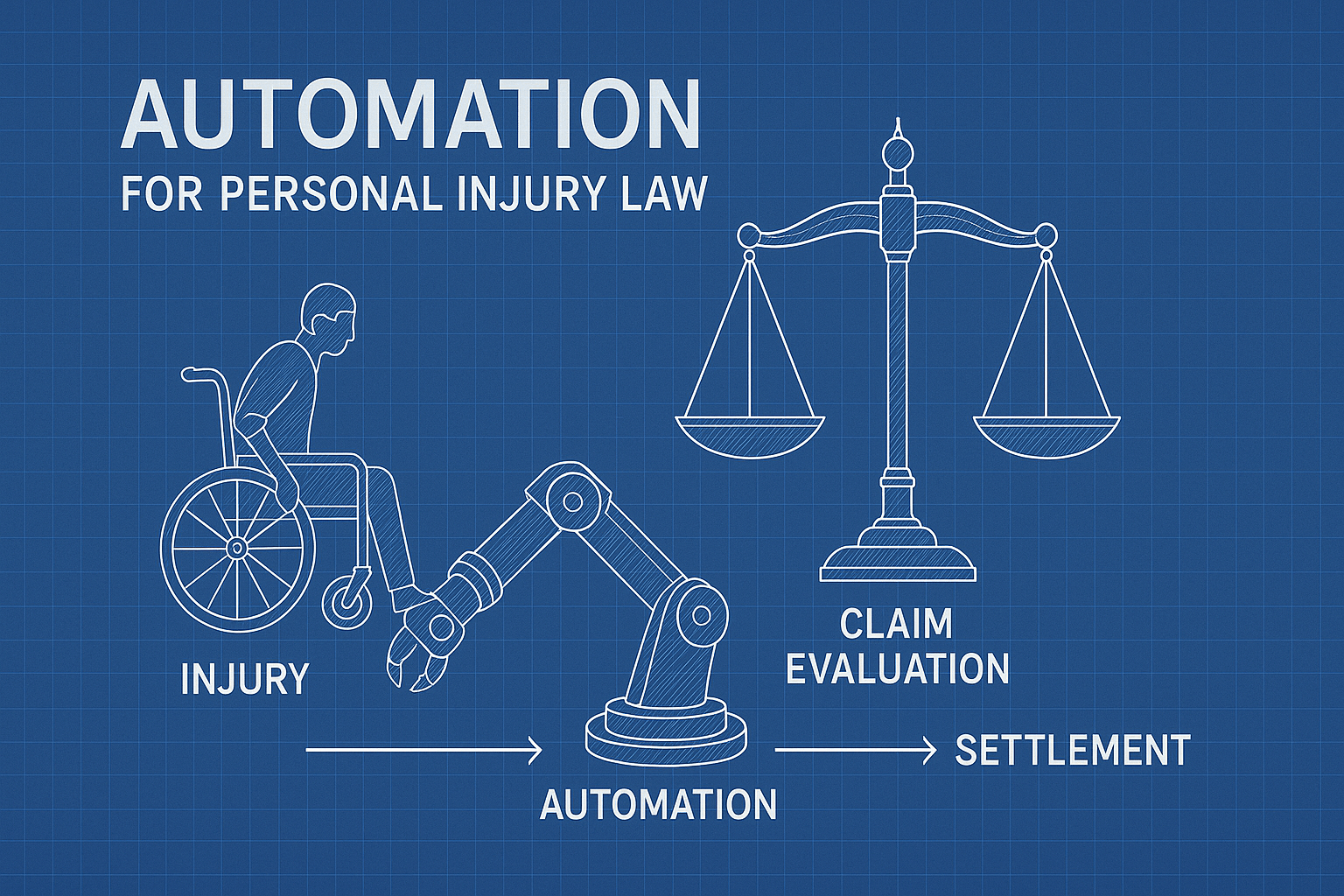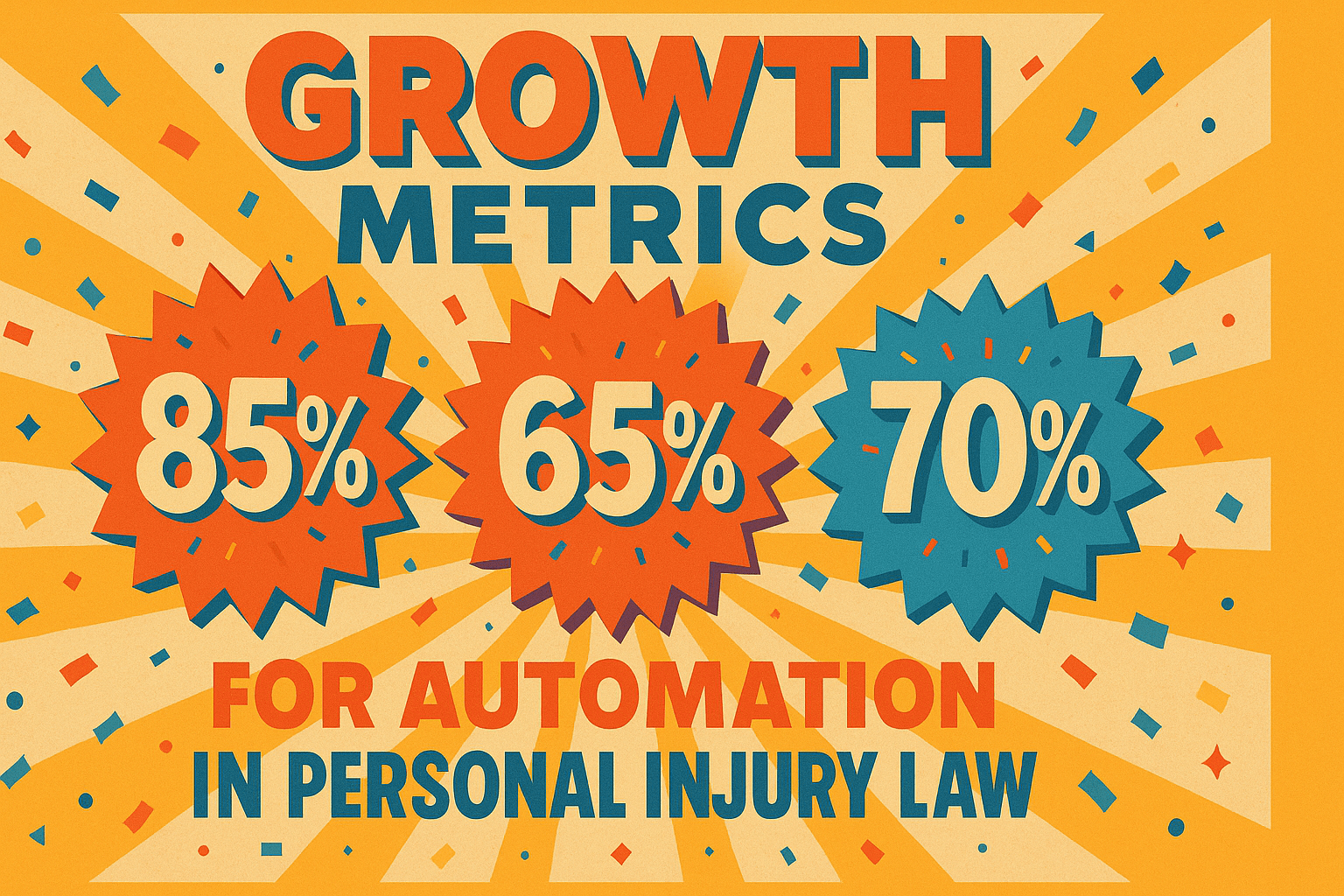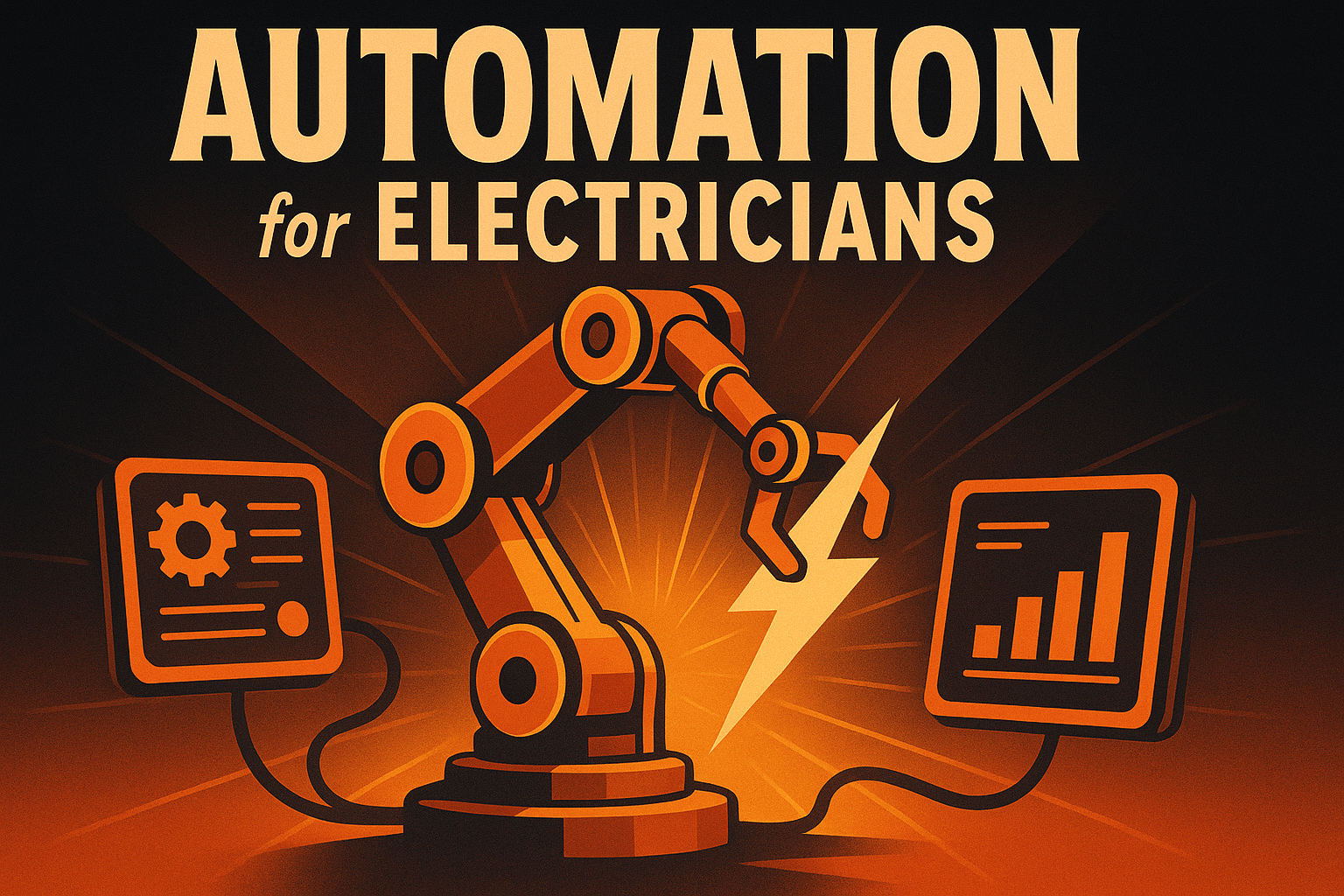How Automation Transforms Personal Injury Law Firms: Complete Guide to Scaling Client Acquisition and Case Management
by Design Delulu Editorial · October 12, 2025

In an increasingly competitive legal landscape, personal injury law firms face a critical challenge: how to handle growing caseloads while maintaining the personalized attention that wins cases and builds client trust. Manual processes that worked for 10 cases per month become bottlenecks at 50, and what sufficed for a solo practitioner creates chaos for a growing team. Automation isn't about replacing the human expertise that defines exceptional legal representation—it's about eliminating the repetitive tasks that prevent attorneys from focusing on what they do best: winning cases and serving clients.
The firms that thrive in today's market understand a fundamental truth: scalability requires systems, not just stamina. When client intake takes 45 minutes of manual data entry, when follow-up emails are typed individually, when case status updates require hunting through scattered spreadsheets, growth doesn't just slow—it stalls completely. Strategic automation transforms these friction points into competitive advantages, allowing firms to handle 3x the caseload without proportionally expanding overhead, respond to leads in minutes instead of hours, and maintain consistent client communication that builds trust and referrals. The question isn't whether to automate, but how to implement automation that aligns with your firm's unique workflow and growth trajectory.

Why Personal Injury Law Firms Need Automation Now
The personal injury legal market has fundamentally shifted in the past five years. Potential clients now expect immediate responses—studies show that 78% of clients choose the first firm that responds to their inquiry. Meanwhile, the average personal injury case requires coordination across multiple stakeholders: clients, medical providers, insurance adjusters, expert witnesses, and court staff. Managing these relationships manually creates inevitable gaps where cases stall, clients feel neglected, and revenue opportunities slip away.
Consider the typical intake process: a potential client fills out a web form at 9 PM. Without automation, that lead sits until morning, then waits in an inbox until someone manually reviews it, enters data into your case management system, assigns it to an attorney, and finally reaches out—often 24-48 hours later. By that time, the client has likely connected with two or three competing firms. Automation compresses this timeline to minutes: instant acknowledgment, automatic data capture, intelligent routing to the right attorney based on case type and capacity, and immediate scheduling of a consultation call.
Beyond speed, automation creates consistency that manual processes cannot sustain. Every client receives the same high-quality intake experience. Every case follows the same documentation standards. Every deadline triggers the same reliable reminders. This consistency doesn't just improve client satisfaction—it reduces malpractice risk, ensures compliance with bar regulations, and creates the operational foundation necessary for sustainable growth.
The financial impact is equally compelling. Firms implementing comprehensive automation typically see a 40-60% reduction in administrative time costs, a 35% increase in lead-to-client conversion rates, and a 25% improvement in average case value due to better documentation and follow-through. For a firm generating $2 million in annual revenue, these improvements translate to $400,000+ in additional net income—enough to hire additional attorneys, invest in marketing, or significantly improve profit margins.
Core Automation Systems That Transform Personal Injury Practices
Effective automation for personal injury law firms operates across three interconnected domains: client acquisition, case management, and business intelligence. Each domain addresses specific bottlenecks while contributing to an integrated system that compounds value over time.
Client Acquisition Automation begins the moment a potential client discovers your firm. This includes automated tracking of all lead sources (organic search, paid ads, referrals, social media) with proper attribution, instant lead capture and acknowledgment regardless of time or day, intelligent lead scoring based on case value indicators, automated routing to appropriate attorneys based on specialization and availability, and scheduling systems that eliminate phone tag by offering instant calendar booking.
The most sophisticated firms extend this automation to nurture campaigns that educate prospects through the decision-making process. When a potential client isn't ready to retain immediately—perhaps waiting for medical treatment to conclude—automated email sequences maintain engagement with valuable information about their rights, the claims process, and what to expect. This positions your firm as the trusted authority when they're ready to move forward.
Case Management Automation transforms how your team handles active cases. This encompasses automatic document collection and organization with client portals for secure upload, template-based document generation for common filings and correspondence, deadline tracking with cascading reminders to prevent missed statutes of limitations, automated client status updates at key milestones, medical records request tracking and follow-up, and settlement demand package assembly that pulls together all necessary documentation.
Consider the medical records collection process—typically one of the most time-consuming aspects of personal injury cases. Automated systems can generate and send records requests to all relevant providers, track responses, send automatic follow-ups for non-responders, organize received records by provider and date, and flag key information for attorney review. What once consumed 5-8 hours of paralegal time per case becomes a 15-minute oversight task.
Business Intelligence Automation ensures your firm operates on data rather than assumptions. This includes real-time dashboards showing case pipeline and revenue projections, automated financial reporting with case-level profitability analysis, marketing attribution showing which channels generate the highest-value cases, team productivity metrics that identify training needs and capacity constraints, and predictive analytics that forecast case outcomes and settlement values.
These systems answer critical questions that manual processes leave unclear: Which marketing channels deliver clients with the highest average case value? Which attorneys or paralegals handle cases most efficiently? What percentage of cases settle within your target timeline? Where in your process do potential clients drop off? Armed with these insights, you can make data-driven decisions about where to invest resources for maximum impact.

Implementation Strategy: Building Your Automation Foundation
Successful automation implementation follows a phased approach that delivers quick wins while building toward comprehensive transformation. The key is starting with high-impact, low-complexity automations that demonstrate value and build team confidence before tackling more complex integrations.
Phase 1: Discovery and Assessment begins with mapping your current workflows to identify bottlenecks and inefficiencies. This involves documenting how leads currently flow from initial contact to signed retainer, how cases progress from intake through settlement or trial, how client communication is managed across the case lifecycle, and how data moves between your various tools and systems. Most firms discover they're using 8-12 disconnected tools that create manual handoffs and data re-entry.
Simultaneously, establish clear success metrics aligned with firm goals. If your primary objective is growth, focus on metrics like lead response time, lead-to-client conversion rate, and cost per acquired client. If efficiency is the priority, track attorney utilization rates, case processing time, and administrative cost per case. These metrics become the scorecard for measuring automation impact.
Phase 2: Quick Wins and Foundation implements automations that deliver immediate value while establishing the technical infrastructure for future expansion. Priority targets include automated lead acknowledgment and routing, consultation scheduling automation, basic case status email templates, deadline reminder systems, and unified intake forms that populate your case management system.
These automations typically deploy in 2-3 weeks and immediately improve client experience while freeing 10-15 hours per week of staff time. Equally important, they establish the integration patterns and data standards that enable more sophisticated automation later.
Phase 3: Process Optimization tackles the more complex workflows that drive significant efficiency gains. This includes automated document assembly for common filings and correspondence, medical records collection and tracking systems, client portal implementation for secure communication and document sharing, automated financial workflows for trust account management and billing, and CRM integration that connects marketing, sales, and case management.
These systems typically require 4-8 weeks to implement properly, as they involve more complex integrations, template development, and team training. However, they often deliver the largest efficiency gains—firms commonly report 30-40 hour weekly time savings at this phase.
Phase 4: Intelligence and Optimization implements the analytics and reporting systems that enable data-driven decision making. This includes comprehensive dashboards showing real-time firm performance, marketing attribution reporting that connects ad spend to signed cases, predictive analytics for case value and settlement timing, and automated reporting that keeps stakeholders informed without manual report generation.
This phase transforms automation from operational tool to strategic asset. You can now identify exactly which marketing channels generate profitable cases, which practice areas offer the best growth opportunities, and where process improvements will have the greatest impact.
Technology Stack: Choosing the Right Tools
The personal injury law technology landscape includes hundreds of specialized tools, each promising to solve specific problems. However, the most effective automation strategies focus on integration and interoperability rather than feature count. The goal is a cohesive system where data flows seamlessly between tools, not a collection of disconnected applications.
Core Case Management Platform serves as your system of record. Leading options for personal injury firms include Filevine, Litify (Salesforce-based), Smokeball, CASEpeer, and MyCase. The right choice depends on firm size, growth trajectory, and technical sophistication. Smaller firms often prioritize ease of use and all-in-one functionality, while larger firms may prefer platforms that offer deeper customization and integration capabilities.
Critical evaluation criteria include native automation capabilities, API access and integration options, mobile functionality for attorneys working remotely, client portal features, and scalability to support growth without requiring platform migration.
Client Communication Hub manages all client interactions across channels. This might integrate into your case management system or operate as a separate but connected platform. Key capabilities include secure messaging and document sharing, automated status update emails, SMS notification options for time-sensitive updates, and video conferencing integration for virtual consultations.
Personal injury clients often experience stress and uncertainty. Automated but personalized communication that keeps them informed reduces client anxiety, decreases inbound calls asking for updates, and improves satisfaction and referral rates.
Marketing and Analytics Stack connects your client acquisition efforts to case outcomes. Essential components include CRM for lead management and nurturing, website chat and form tools with instant response automation, call tracking and recording for quality assurance, marketing automation platform for email campaigns, and analytics tools connecting marketing spend to revenue.
The most powerful implementations create closed-loop attribution: you can trace every signed case back to the specific ad, keyword, or referral source that generated the lead, then analyze which sources produce the highest-value cases. This enables sophisticated ROI-driven marketing optimization that manual tracking cannot support.
Integration Platform connects your various tools into a cohesive system. Options like Zapier, Make (formerly Integromat), or custom API integrations enable data to flow automatically between systems. For example, when a new lead comes from your website, the integration platform can create the case record, send acknowledgment emails, add the contact to your CRM, create calendar events, and notify the assigned attorney—all without manual intervention.
While integration platforms add complexity, they're essential for creating truly automated workflows that span multiple tools. The alternative—manual data entry and cross-platform management—quickly becomes unsustainable as case volume grows.
Measuring Success: KPIs That Matter for Automated Personal Injury Firms
Automation without measurement is blind; you need clear metrics to understand what's working, what needs adjustment, and where to invest further. Personal injury firms should track metrics across three categories: operational efficiency, client acquisition effectiveness, and case profitability.
Operational Efficiency Metrics measure how effectively your team operates: lead response time (target: under 5 minutes for initial acknowledgment), intake completion time (target: 30 minutes or less from lead to signed retainer), time spent on administrative tasks versus billable work (target: 70%+ billable), case processing time from signing to resolution, and cost per case in administrative overhead.
Track these metrics weekly and investigate outliers. If lead response time suddenly increases, is it a staffing issue or a technical problem? If case processing time extends, are specific case types or team members creating bottlenecks? Automation creates the data visibility to answer these questions definitively.
Client Acquisition Metrics evaluate marketing effectiveness and conversion efficiency: lead-to-consultation conversion rate (target: 60%+), consultation-to-signing conversion rate (target: 40%+), cost per acquired client by channel, average case value by lead source, and client satisfaction scores and net promoter score.
The most valuable insight comes from connecting acquisition cost to case value. A marketing channel that generates cheap leads but low-value cases may be less profitable than an expensive channel producing high-value cases. Automation enables this level of analysis by tracking attribution from first contact through case resolution.
Case Profitability Metrics ensure your cases generate healthy returns: average settlement/verdict value by case type, attorney time investment per case, cost of medical record collection and expert witnesses, time from signing to settlement/verdict, and net revenue per case after all costs.
These metrics inform strategic decisions about which case types to pursue aggressively versus those to handle selectively. They also reveal whether certain attorneys or case managers achieve better outcomes, enabling you to study and replicate their approaches.

Common Pitfalls and How to Avoid Them
While automation offers tremendous benefits, implementation can stumble on predictable obstacles. Understanding these pitfalls in advance enables proactive mitigation.
Over-Automation Too Quickly creates chaos rather than efficiency. Teams overwhelmed by simultaneous changes disengage or work around new systems rather than embracing them. Solution: implement in phases with clear success criteria before advancing. Ensure each automation works reliably and delivers measurable value before adding complexity.
Neglecting Change Management dooms even technically perfect automations. If staff don't understand why changes are happening, how to use new tools, or what's in it for them, adoption fails. Solution: involve team members in workflow design, provide comprehensive training with hands-on practice, celebrate early wins publicly, and address concerns promptly and transparently.
Sacrificing Personalization in pursuit of efficiency alienates clients. Automated emails that feel robotic, missed nuances in client situations, or removing human touchpoints at critical moments damage relationships. Solution: use automation to handle routine tasks while freeing staff to provide personalized attention where it matters most. Build personalization variables into automated communications. Establish clear escalation paths from automated to personal contact.
Ignoring Data Quality undermines automation effectiveness. If your case management system contains duplicate records, inconsistent data entry, or outdated information, automation built on that foundation produces unreliable results. Solution: conduct data cleanup before implementing automation, establish clear data entry standards and enforce them, implement validation rules that prevent bad data entry, and schedule regular data quality audits.
Building Disconnected Automations creates maintenance nightmares. Each system operating independently requires separate updates, training, and management. Solution: prioritize integration from the start, choose tools with robust API access, invest in integration platforms or custom development when necessary, and maintain clear documentation of how systems connect.
The Future of Automation in Personal Injury Law
Automation technology continues evolving rapidly, and personal injury firms that stay current gain competitive advantages. Three emerging trends deserve attention: AI-powered document review and case evaluation, predictive analytics for settlement negotiation, and enhanced client self-service capabilities.
AI Document Review is transitioning from experimental to practical. Systems can now review medical records and highlight potentially relevant information, analyze comparable case settlements to inform valuation, draft initial versions of routine documents for attorney review, and identify missing documentation that might strengthen cases. While these systems require attorney oversight, they dramatically accelerate work that previously consumed dozens of hours per case.
Predictive Analytics help firms make better strategic decisions about cases. By analyzing thousands of historical cases, machine learning models can estimate likely settlement values based on injury type, jurisdiction, and case facts, predict which cases are likely to settle versus require litigation, identify optimal timing for settlement demands, and forecast trial outcomes with increasing accuracy. These capabilities don't replace attorney judgment but inform it with data-driven insights.
Enhanced Self-Service empowers clients to access information and complete tasks without staff intervention. Advanced client portals now support clients uploading documents via smartphone, checking case status and upcoming events 24/7, accessing educational content explaining legal processes, securely reviewing and e-signing documents, and communicating with your team via their preferred channel. This simultaneously improves client satisfaction and reduces routine administrative work.
The firms that will dominate personal injury law over the next decade are those that view automation not as a one-time project but as an ongoing competitive discipline—continuously identifying inefficiencies, implementing solutions, measuring results, and iterating toward excellence.
Frequently Asked Questions
Let’s level up your Personal Injury Law business
Need services that actually move the needle for Personal Injury Law? See our approach, pricing, and timelines—then book a quick call.
Additional Resources
- Schedule Your Personal Injury Law Automation Consultation
Book a complimentary 30-minute strategy session to discuss your firm's specific challenges, explore automation opportunities tailored to your practice, and receive a customized implementation roadmap with timeline and investment details.
- View Our Personal Injury Law Automation Portfolio
Explore case studies and real-world examples of how we've helped personal injury law firms implement automation systems that increased client acquisition, improved case management efficiency, and scaled revenue without proportionally expanding overhead costs.
- Access Free Personal Injury Law Automation Tools
Download our collection of free resources including automation readiness assessments, workflow mapping templates, ROI calculators, and implementation checklists designed specifically for personal injury law practices looking to streamline operations.
Related Reading

Discover how automation for electricians streamlines scheduling, invoicing, lead tracking, and customer follow-ups to boost revenue and efficiency. Get started today.

Discover how automation streamlines furniture & home decor operations with GA4 tracking, attribution modeling, and data-driven dashboards. Get your 90-day implementation roadmap.
